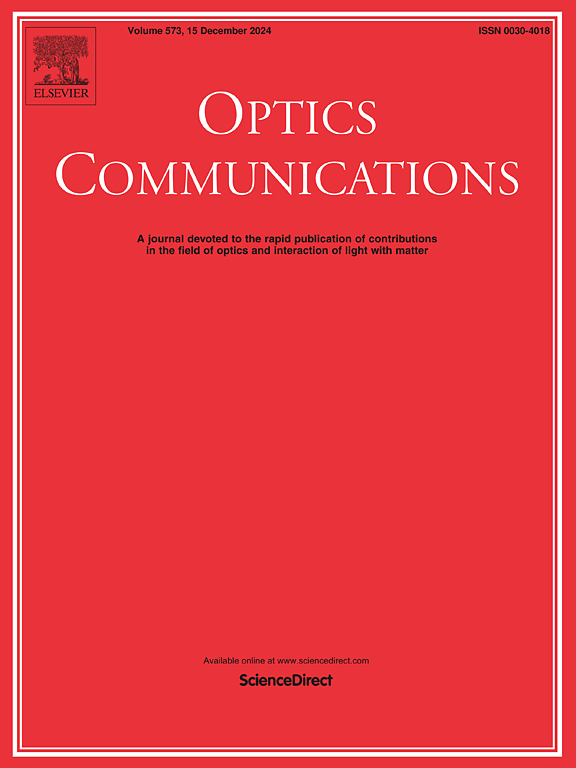利用大功率激光对透明电介质制成的分散介质进行辐射破坏的初始阶段形成的光学共振
IF 2.5
3区 物理与天体物理
Q2 OPTICS
引用次数: 0
摘要
通过数值模拟,我们研究了当来自镱光纤激光器(λ = 1065 ± 3.25 nm)、蓝色二极管激光器(λ = 450±8 nm)或二氧化碳激光器(10.6 μm)的辐射散射到透明电介质(氧化物、氟化物、硒化锌)的单个粒子上时,以及在不同大小的随机排列粒子的集合体中产生的光学共振。如果粒子直径与辐射波长相当(但不小于 3λ/4),那么在粒子直径、其材料折射率和辐射波长达到一定比例时,粒子就会成为微谐振器。颗粒内部或外部散射辐射的最大强度取决于上述参数的组合,可以超过入射辐射强度的数十倍。在粉末的情况下,所有粒子同时形成干涉图案,更有可能发生光学共振。即使镱激光器或蓝色二极管激光器的辐射波长稍有变化(在激光线宽范围内),粉末中的一些颗粒也会变成微谐振器,而另一些颗粒则不再是微腔。因此,在粉末光学破坏的初始阶段,镱激光的散射辐射在单个颗粒中的浓度起着关键作用。正如实验所显示的那样,通过低强度(0.46 MW/cm2)的镱激光器辐射脉冲,可以克服由各种透明物质(CaF2、SiO2、BaF2、YbF3、Fe:MgAl2O4、Al2O3、1mol.%Nd:Y2O3、YSZ、TiO2、ZnSe)制成的多孔目标的光学破坏阈值。随着材料折射率从 1.429(CaF2)增加到 2.479(TiO2),激光羽流形成的平均延迟时间从 46 毫秒减少到 25 微秒,即减少了三个数量级。这与计算中激光在粉末中散射的最大辐射强度随着 n 的增加而增加这一事实相关。与此相符的是通过镱激光脉冲周期辐射从透明氧化物和硒化锌中获得纳米粉体的结果。纳米粉末 Yb0.05:Y1.95O3:(ZrO2)0.05(n = 1.901)(对于 Y2O3)的产量为 15 克/小时,而 ZnSe(n = 2.482)的产量最大(100 克/小时)。同时,CaF2(n = 1.429)无法获得纳米粉体,因为移动靶不会蒸发。本文章由计算机程序翻译,如有差异,请以英文原文为准。
Formation of optical resonances at the initial stage of radiation destruction of disperse medium made of a transparent dielectric by means of a powerful laser
By means of numerical simulation, we study optical resonances that arise when radiation from an ytterbium fiber laser (λ = 1065 ± 3.25 nm), a blue diode laser (λ = 450±8 nm) or a CO2 laser (10.6 μm) is scattered on a single particle of a transparent dielectric (an oxide, a fluoride, ZnSe), as well as in an ensemble of randomly packed particles of various sizes. If the particle diameter is comparable to the radiation wavelength (but is no less than 3λ/4) then, at a certain ratio between the particle diameter, the refractive index of its material and the radiation wavelength, the particle becomes a microresonator. The maximum intensity of scattered radiation inside or outside such particle depends on the combination of the above-said parameters and can exceed the intensity of the incident radiation dozens of times. In case of a powder, the interference pattern is formed by all particles at once and, occurrence of an optical resonance is more likely. Even with a slight change in the radiation wavelength of an ytterbium laser or a blue diode laser (within the lasing line width), some particles in the powder become microresonators, while others cease to be microcavities. Therefore, concentration of scattered radiation of the ytterbium laser in individual particles plays a key role at the initial stage of optical destruction of the powder. As the experiment shows, this allows to overcome the threshold of optical destruction of porous targets made of various transparent substances (CaF2, SiO2, BaF2, YbF3, Fe:MgAl2O4, Al2O3, 1mol.%Nd:Y2O3, YSZ, TiO2, ZnSe) by means of a radiation pulse from an ytterbium laser having low intensity (0.46 MW/cm2). With the refractive index of the material increasing from 1.429 (CaF2) to 2.479 (TiO2), the average delay in the formation of a laser plume decreases from 46 ms to 25 μs, i.e. by three orders of magnitude. This correlates with the fact that in the calculations, the maximum intensity of this laser's radiation scattered in the powder increases with n increasing. In compliance with this are the results of obtaining nanopowders from transparent oxides and ZnSe by means of pulse-periodic radiation of an ytterbium laser. Output of the nanopowder Yb0.05:Y1.95O3:(ZrO2)0.05 with n = 1.901 (for Y2O3) is 15 g/h, and the maximum output (100 g/h) is realized in case of ZnSe (n = 2.482). At the same time, it is not possible to obtain nanopowder from CaF2 (n = 1.429), because the moving target does not evaporate.
求助全文
通过发布文献求助,成功后即可免费获取论文全文。
去求助
来源期刊

Optics Communications
物理-光学
CiteScore
5.10
自引率
8.30%
发文量
681
审稿时长
38 days
期刊介绍:
Optics Communications invites original and timely contributions containing new results in various fields of optics and photonics. The journal considers theoretical and experimental research in areas ranging from the fundamental properties of light to technological applications. Topics covered include classical and quantum optics, optical physics and light-matter interactions, lasers, imaging, guided-wave optics and optical information processing. Manuscripts should offer clear evidence of novelty and significance. Papers concentrating on mathematical and computational issues, with limited connection to optics, are not suitable for publication in the Journal. Similarly, small technical advances, or papers concerned only with engineering applications or issues of materials science fall outside the journal scope.
 求助内容:
求助内容: 应助结果提醒方式:
应助结果提醒方式:


